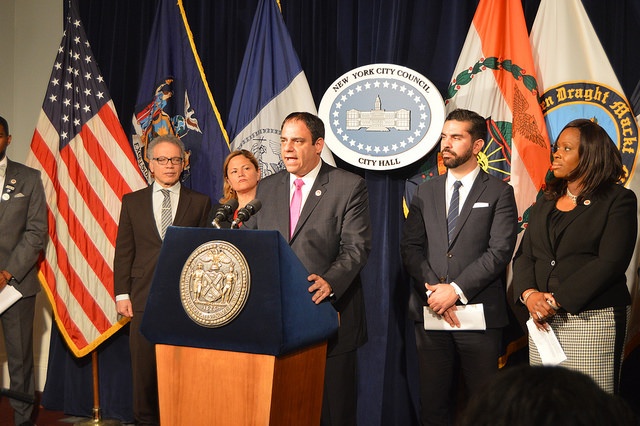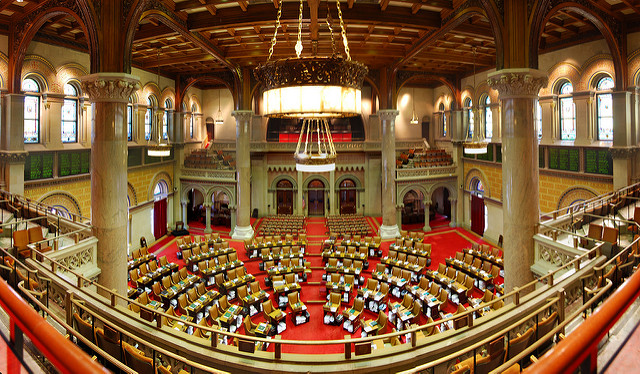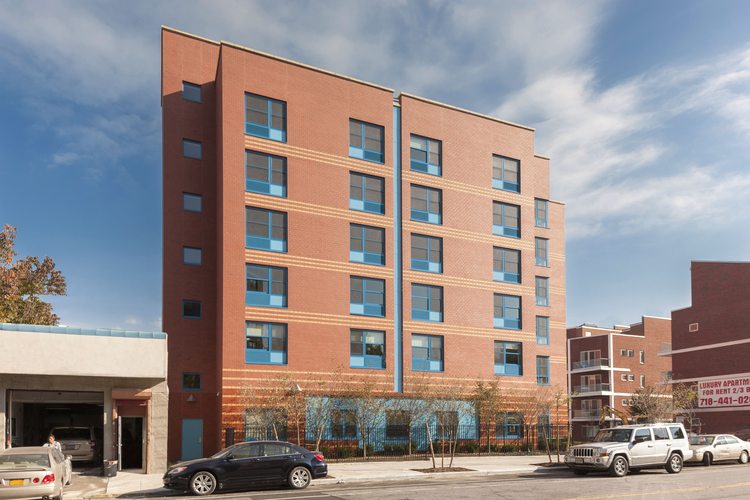New Urgency in Our City’s Fight for Our Planet’s Future

Council Member Constantinides, the author
As we continue to digest the results of the election, a troubling reality emerges that our core beliefs are under attack. As New Yorkers, we stand in unity with our neighbors, especially Muslim, Latino, and LGBTQ communities across our city.
We are also left with deep disappointment because President-elect Trump has attacked climate change as a hoax. He has pledged to undo American efforts to prevent a global warming catastrophe, including retreat from the Paris Agreement on Climate, Clean Power Plan, and new EPA regulations.
It is clear that our city and other local governments need to lead the way on protecting equality, as well as protecting our planet.
As Chair of the New York City Council's Environmental Protection Committee, I remain focused on making our city greener and more sustainable. We learned four years ago with Hurricane Sandy that the effects of climate change can cause devastating damage to our homes, infrastructure, and places we hold dear. Since then, New York has made great strides in resilience and sustainable building.
With a strong environmental partner in Mayor de Blasio, we have already begun working toward our commitment to reduce our carbon emissions 80% by 2050 and continue to invest in environmental education and programming. The City Council recently passed legislation I sponsored to boost renewable energy including solar, geothermal, and bioheat.
We have also helped encourage sustainable habits such as taking public transportation more and using less air conditioning. Earlier this month, we passed a bill, Intro. 1124, which will encourage more New Yorkers to drive electric vehicles by implementing a pilot program for publicly accessible charging stations.
On Monday, I will chair an Environmental Protection Committee oversight hearing on emissions that come from power plants throughout the city.
It is time for us to be bolder in our efforts to lead on environmental policy, through innovative policies and careful oversight, like the efforts mentioned above.
We have introduced legislation that advocates for environmental justice in our most underserved communities, making New York the first large city in the nation that would have such a commitment.
Knowing that 75% of our emissions come from buildings, we are exploring the use of wind energy in our city, allowing neighbors to tap into the same geothermal energy source to power their own homes, and solar thermal installation on city-owned buildings. New York has already been a worldwide role model in sustainability and we must continue to keep this work a top priority.
Now is the time that we must stand up and fight for our planet’s future.
***
City Council Member Costa Constantinides represents the 22nd Council District, which includes his native Astoria along with parts of Woodside, East Elmhurst, and Jackson Heights. He serves as Chair the Council's Environmental Protection Committee and sits on six additional committees. On Twitter @Costa4NY.
***
Have an op-ed idea or submission for Gotham Gazette? Email This email address is being protected from spambots. You need JavaScript enabled to view it.
The Best Delegate Election Process for a New York Constitutional Convention

NYS Assembly chamber (photo: MattWade on flickr)
On November 7, 2017, New Yorkers will be asked to vote on whether to call a state constitutional convention. When this question was last on the ballot in 1997 (it’s required to be on the ballot once every 20 years), the most publicized argument not to call a convention was that the convention delegate election process would be dominated by the same interests that dominate New York’s Legislature.
That argument fails to account for the many successes of America’s 236 state constitutional conventions since 1776, including New York’s nine. It also fails to explain why the same special interest groups who would supposedly benefit from a convention will spend millions of dollars opposing one. Except for the fact that incumbent public officials can run as delegates, New York has one of the best delegate election processes among the states.
But, there is still much room for improvement.
New York’s Delegate Election Process
New York’s Constitution mandates what’s known as a mixed delegate election system. Of the 204 delegates to be elected, 189 are elected from New York’s 63 state Senate districts (three from each district) and 15 elected at large for the entire state. Crucially, the details of how this mixed system works are left up to the discretion of the Legislature.
The last time the Legislature chose the election details it created a system whereby in each Senate district voters voted up or down for three candidates, and in the at-large election voted up or down for a party-based slate of candidates (see the sample ballot below).

A Better Delegate Election Process
A better mixed system would be built on a foundation of what political scientists call Mixed Member Proportional (MMP), a type of electoral system used in Germany and New Zealand at the national level; and Scotland, Wales, and more than a dozen German states at the regional level. In a 2006 survey, political scientists who specialize in electoral systems ranked MMP as the best family of electoral systems.
Part of the MMP mix would include ranked-choice voting, a type of electoral system used in Ireland and Australia at the national level, and in many U.S. cities at the local level. In 2016, Maine voters approved a ballot initiative to choose the Governor and state Legislature via ranked-choice voting. In the same 2006 survey, ranked-choice voting was ranked the second-best family of electoral systems.
In an MMP system, voters cast two types of votes: one for candidates in their local district, and one for a party. The votes, in turn, count for two tiers of seats: a local candidate tier, and a compensatory tier for parties that didn’t win seats in the candidate vote in proportion to their party vote. Within the constraints of New York’s current constitution, this could work as follows:
In choosing candidates from their local three-member Senate district, voters would rank their preferences rather than vote up or down for each candidate. Such a “ranked-choice” voting system wouldn’t require separate primary and general elections because runoffs are instant. Most important, it wouldn’t penalize voters for voting for their first choice rather than a less preferred candidate with a better chance of winning. With New York’s three-member districts, any district candidate with 25% of the vote plus one would win a district seat, thus strengthening party competition and mitigating the harmful effects of partisan gerrymandering.
The party votes would be used to ensure that the ratio of seats to votes is proportional. For example, assume the Democratic Party gets 49% of the vote, the Republican Party 46%, and an independent party 5%. Under the current delegate election system, the Democratic and Republican parties would most likely win 100% of the seats. But under MMP, the independent party would be entitled to 5% of the overall seats and thus win ten of the fifteen at-large seats, with the balance divided proportionately among the Democrats and Republicans. The result of such compensatory seats is that small parties and political entrepreneurs would have a much greater incentive to compete in the election.
Each party would compile its list of candidates for proportional allocation the way it wanted. For example, a party could add the proportion of a candidate’s district vote (e.g. the number of top-three votes) to the proportion of the party’s district vote to come up with a candidate’s party list ranking. Many other methods could also be used.
When a delegate’s seat became vacant, the party would choose the next name on its list as a replacement. No special election would be held.
Although the 15 at-large, compensatory seats might seem to guarantee a relatively small amount of proportionality, the combination of ranked-choice voting in the three-member districts plus the compensatory seats would lead to a remarkably high degree of proportionality (although having more compensatory seats would be even better).
A state-of-the-art electoral system should provide not only voters, but also parties and candidates, with more options consistent with the principle of political equality and robust public deliberation. Mixed Member Proportional (MMP) combined with ranked-choice voting accomplishes that.
Party-Based Electoral Competition is Good
In the United States, the media teaches the public to think disdainfully of political parties. Consequently, the word “partisan” has become a dirty word. But contemporary democracy is unthinkable without parties, and party labels are an extremely efficient and effective system for educating the public about candidates. MMP offers the best of both party- and candidate-centered elections while radically diminishing the need for public financing of elections.
States have had many democracy enhancing constitutional conventions that were dominated by two-party delegate competition, including New York’s famous state ratifying convention in 1788 that was dominated by Federalists and Anti-Federalists (the Anti-Federalists won the most delegate seats but were eventually convinced to side with the Federalists). The chief worry should not be party but incumbent legislator dominated conventions. Only the latter type of domination violates the core democratic function of a convention, which is to bypass the Legislature’s gatekeeping power over constitutional amendment. Still, using MMP to lower barriers to entry for both parties and candidates would greatly strengthen the delegate election process by providing voters with more meaningful choices.
New York’s past practice of having candidates outside the two major parties run as a slate is a vastly inferior alternative to MMP but probably the best that New York’s Legislature would allow if voters approved calling a convention. Thus, reform groups may focus their efforts on putting together a slate. In 1966, when New York last had a delegate election, such efforts were remarkably successful—albeit still inadequate (7% of the elected delegates were incumbent legislators).
 Getting to MMP
Getting to MMP
The politics of improving the delegate election process are admittedly dismal. Legislatures hate conventions because they function as a check on their power, so the last thing they want to do is strengthen the institution. Ditto for the powerful special interest groups that thrive working through the Legislature and thus view a convention as a threat.
One reason for hope is that federal courts could rule that the delegate election system approved by the Legislature for the three-member districts violates the proportional requirements under Section 2 of the Voting Rights Act. The 1965 Voting Rights Act was passed just before the last delegate election took place in 1966. If the Legislature doesn’t change the type of system it approved in early 1966, it is likely to be sued under that law. That could give the federal courts the ability to design a more proportional electoral system such as single-member districts (the courts’ conventional remedy based on using an up-or-down voting rule) or ranked-choice voting within the constraints of New York’s constitutionally specified three-member districts.
The best long-term hope for meaningful delegate election reform is the political logic of the famous “veil of ignorance” effect regarding democratic reforms that won’t take effect for at least 20 years into the future. The basic idea is that even crassly self-interested convention delegates would have an incentive to support democracy enhancing reforms such as MMP if they wouldn’t take effect until after those delegates would be retired from politics and couldn’t foresee how they would personally benefit from preserving an otherwise inferior status quo.
Most of those using the delegate election process as an argument against calling a convention are using that argument as a pretext for opposition on other grounds. But they do have a point, so those who aren’t using that argument as a pretext should direct their energies to fixing the process either through the Legislature and courts or, if that’s not possible, the next convention.
The U.S. Declaration of Independence asserts that Americans should have an “unalienable” right to “alter” their form of government, including the right to peaceably bypass their legislatures’ gatekeeping power over needed democratic reforms. The inter-generational struggle to protect and enhance this most fundamental of all democratic rights should dwarf considerations of short-term expediency. The cure for the deficiencies of the current process, like democracy itself, is a better process, not the eternal tyranny of the legislature over the constitutional amendment process.
Like all electoral systems, a Mixed Member Proportional (MMP) system with ranked-choice voting is not perfect. But to safeguard our most fundamental of all democratic rights, it would be a great legacy for us to leave to future generations of New Yorkers.
***
J.H. Snider, the president of iSolon.org, is the editor of The New York State Constitutional Convention Clearinghouse and author of Does the World Really Belong to the Living? The Decline of the Constitutional Convention in New York and Other US States, 1776–2015.
***
Have an op-ed idea or submission for Gotham Gazette? Email This email address is being protected from spambots. You need JavaScript enabled to view it.
Housing, Not Handcuffs, Is the Solution to Rising Homelessness

Urban Pathways residence in Queens (photo via Urban Pathways)
Across the United States, cities continue to adopt laws criminalizing homelessness and poverty as their first line of defense against rising homelessness. According to a 2014 study of 187 U.S. cities by the National Law Center on Homelessness and Poverty, 100 cities have banned sitting or lying down in public places and 81 cities have prohibited sleeping in one’s own vehicle, increases of 43 percent and 119 percent, respectively, since 2011.
Criminalization of homelessness occurs in many forms. Palo Alto, CA made sleeping in one’s own vehicle a crime punishable by a $1,000 fine or up to six months in jail. In June, Saratoga Springs, NY banned sitting or lying on sidewalks. While federal courts increasingly find these laws unconstitutional, cities still adopt them, appeasing some constituents with “tough” measures disconnected from proven solutions to homelessness.
Even for cities like New York that don’t adopt these bans, criminalization persists, with similar consequences for those criminalized. City laws – such as the city transit code prohibition on lying down or taking up more than one seat on the subway - are arbitrarily enforced against those experiencing homelessness. The police also order persons experiencing homeless to “move along” not because there is reasonable suspicion they are engaging in criminal activity but because they are homeless.
Regardless the form, criminalization hurts the person criminalized, policing, taxpayers, and the community. Harm to those criminalized can include a criminal record, fines, or jail, as well as another traumatic experience added to that of being homeless. It impedes community policing, compromising the already attenuated relationship between communities and the police who are to protect and serve them. It is a waste of money, using significant tax dollars for policing and court time, and too often involving the expensive corrections system. Criminalization also accomplishes nothing for the person experiencing homelessness or the city enacting the ordinance, since these laws and their enforcement don’t address the root causes of homelessness.
It is the central cause of homelessness, the dearth of truly affordable housing, on which we must focus, doing all within our power to constantly protect low-income tenants and facilitate the tenancy of those without access to affordable housing. In New York City this includes strongly enforcing our fair housing laws, including the Human Rights Law’s protection against source-of-income discrimination. We only impede shelter exits when we allow landlords to refuse to rent to a person because they have a Living in Communities rental voucher.
In this spirit, today, the National Law Center on Homelessness and Poverty launches a national campaign advocating for “Housing Not Handcuffs.” The campaign has two principles: 1) To end the homelessness crisis, the criminalization of homelessness must end; and 2) All persons experiencing homelessness should instead have access to affordable housing, education, health care, employment, income, and other opportunities and services that allow all to live with dignity.
Tomorrow -- Wednesday, November 16 -- there will be a New York City launch of the national Housing Not Handcuffs campaign at the City Hall steps. The launch, focusing on homeless criminalization and affordable housing in New York City, will feature speakers including Eric Tars of the National Law Center on Homelessness and Poverty as well as individuals who have experienced homelessness criminalization. We will also launch a survey of those experiencing homelessness about criminalization.
You can get involved in the Housing Not Handcuffs Campaign in several ways: Attend and encourage others to attend the New York City launch on Wednesday; Endorse the national Housing Not Handcuffs Campaign; Encourage those experiencing homeless to complete the criminalization survey; Reach out to the NYC Housing Not Handcuffs Campaign at This email address is being protected from spambots. You need JavaScript enabled to view it..
Let’s end the criminalization of homelessness. Handcuffs are not the solution to homelessness; truly affordable housing is.
***
Nicole Bramstedt is Policy Director at Urban Pathways. Jeff Foreman is Policy Director at Care for the Homeless. Both organizations serve homeless adults in New York City. On Twitter: @UrbanPathwaysNY & @CFHNYC.
***
Have an op-ed idea or submission for Gotham Gazette? Email This email address is being protected from spambots. You need JavaScript enabled to view it.




